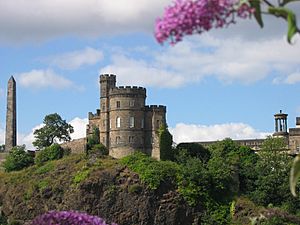Hills in Edinburgh facts for kids
Edinburgh, the capital city of Scotland, is often said to be "built on Seven Hills." This idea is a bit like how the ancient city of Rome was also built on seven hills. While people sometimes disagree about which hills count, an old rhyme lists seven possibilities:
- Abbey, Calton, Castle grand,
- Southward see St Leonards stand,
- St Johns and Sciennes as two are given,
- And Multrees makes Seven.
The Pentland Hills are also very close to the south of Edinburgh. Their lower parts are even inside the city, especially around places like Hillend and Swanston. Some of Edinburgh's hills are actually old volcanoes that stopped erupting about 400 million years ago! All the hills also show signs of being shaped by ancient glaciers.
The story of Edinburgh's seven hills is so popular that many local businesses, like dentists, tour companies, and even music bands, use the name.
Edinburgh's Traditional Seven Hills

There's a bit of a discussion about which hills are truly the "seven." For example, Arthur's Seat and the Braid Hills are actually groups of hills with several peaks, not just one single hill. In total, Edinburgh has ten main peaks that rise at least 30 meters (about 100 feet) above the land around them.
Here are the hills often included in the traditional list:
- Arthur's Seat (251 meters high) is the tallest of the seven. It's an ancient volcano that includes other smaller hills like Salisbury Crags (174 meters) and Dunsapie Hill (145 meters).
- Castle Rock (128 meters) is a volcanic plug, which is like a rock column formed inside a volcano.
- Calton Hill (103 meters) is known for its monuments.
- Corstorphine Hill (162 meters) is a long ridge.
- Braid Hills (213 meters) are a range of hills.
- Blackford Hill (164 meters) is home to an observatory.
- Craiglockhart Hill
Since 1980, a running race has been held every year that includes these seven hills. It starts and finishes on Calton Hill. However, the race actually skips Wester Craiglockhart because it's private land and instead includes the lower Easter Craiglockhart.
Why People Debate 'The Seven'
Before the New Town was built, Edinburgh was mostly just on one hill: the volcanic Castle Rock and the sloping land that stretched east from it. As the city grew in the 1800s and 1900s, first Calton Hill and then the other hills listed above became part of the city. This is why the "traditional seven" are often seen as the main hills within modern Edinburgh.
There are many other hills in Edinburgh! Some are part of the larger hill ranges, and others are simply hidden under buildings and houses. For example, there are ridges extending from areas like Dalry and Ardmillan. Craigmillar Castle also sits on a small hill. Some of these other hills are even taller than the traditional seven, like parts of Fairmilehead at 183 meters (about 600 feet).
The Pentland Hills to the south of Edinburgh are usually thought of as being outside the city. However, they are very close and, because they are so tall, they really stand out when you look south from the city. Allermuir Hill, at 493 meters, is almost twice as tall as Arthur's Seat and not much further from the city center than Corstorphine Hill.
Many Edinburgh neighborhoods also have "hill" or similar words in their names. These include Abbeyhill, Alnwickhill, Church Hill, and Sighthill. Other areas have "Craig" in their name, which means a large rock, like Craigentinny and Craigmillar.
Hills in the City Centre
Edinburgh is also famous for being a very hilly city, especially in its center. The most well-known example is the Royal Mile, a street that goes steadily uphill for about a mile, from Holyrood Palace all the way to Edinburgh Castle.
Other hilly streets in the city center include:
- Dundas Street and Hanover Street, which climb steeply from the Water of Leith river up to George Street. They then go down a little to Princes Street before climbing the very steep Mound to meet the Royal Mile.
- Several streets in the New Town run parallel to Dundas Street and Hanover Street and also have steep sections.
- Leith Walk, which rises continuously from near sea level in Leith up to Princes Street.
- Many short and very steep streets in the Old Town, like Victoria Street and Candlemaker Row.
Because of all these changes in height, Edinburgh has many roads that cross over other roads on bridges. This was quite unusual in Britain before the 1900s. Examples include Waterloo Place, which goes over Calton Road, and George IV Bridge, which crosses over the Cowgate. There are also many staircases just for people walking, connecting streets at different heights. These include Playfair Steps and Jacob's Ladder.
Some of the hills further out from the city center include the climb from Tollcross to Bruntsfield and beyond to Fairmilehead.




